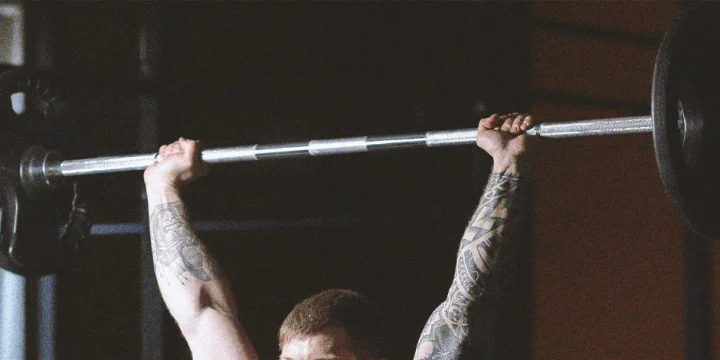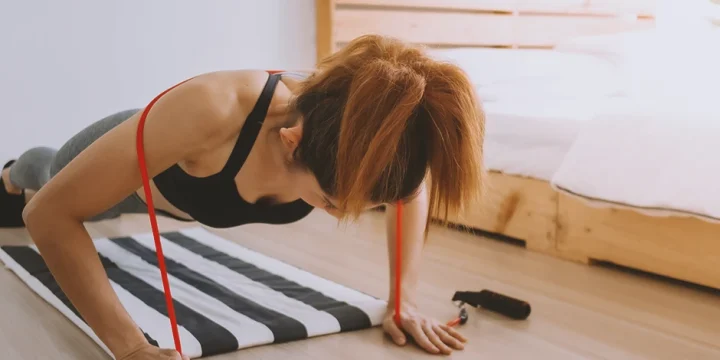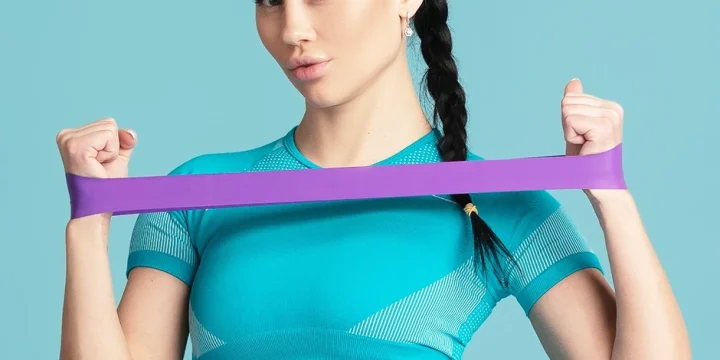Resistance band rows are a practical, versatile exercise I recommend for all fitness levels.
They target your back, core, and arms, increasing strength and muscle tone with the unique tension bands provide.
My experience shows consistent use of band rows leads to improved posture and back strength, often reducing back pain.
This portability and affordability make them a practical fitness tool for anyone.
Based on my observations, resistance bands in rows are highly effective for targeting upper back muscles.
Quick Summary
- To effectively use resistance bands for rows, attach them to an anchor point and perform the exercise while maintaining proper form.
- Resistance band rows enhance back muscle strength and offer various adaptable workouts to keep challenging your body.
- Per a study published by the National Institutes of Health (NIH), resistance bands can lead to gains in strength and power when compared to typical resistance training.
- In my opinion, incorporating resistance band rows into your workout routine is a versatile and efficient way to build a stronger back and enhance overall fitness.
How to Use a Resistance Band in Rows?

I can confidently say that using a resistance band for rows is a fantastic choice. Drawing from my experience, attaching it to an anchor point and following these steps provides higher resistance and better body positioning.
This will provide higher resistance and better body positioning.
Here's a detailed explanation of how you can do a resistance band row:
- Select a band with an appropriate resistance level. A lighter band may be preferable for beginners, while more advanced users might opt for a heavier one.
- Find a sturdy anchor point, like a pole, furniture, or door anchor attachment. Loop the resistance band around it at roughly waist height.
- Stand or sit upright with your feet shoulder-width apart. Slightly bend the knees and engage the abs for stability. Hold the band in both hands.
- Pull the band towards your body. Keep your elbows close to your sides. Your hands should be pulled in towards your abs. Ensure you're driving the movement with your back muscles, not just your arms.
- Release the band and repeat.
Best Resistance Band Rows Exercises

Maximize your back training with these resistance band-row exercises.
Bent Over Rows
Bent over rows with bands fortify your lats, rhomboids, and traps, intensifying stability in your lower back and hamstrings while performing this exercise.
.This exercise is an excellent option for postural improvement and back strength.
How to perform it:
- Stand on the band, feet hip-width apart and holding the ends.
- Bend at your waist. Keep your back straight until your torso is nearly parallel to the floor.
- Pull the bands towards your waist, keeping your elbows close to your body.
- Slowly lower your hands, resisting the band's tension.
Seated Neutral-Grip Row
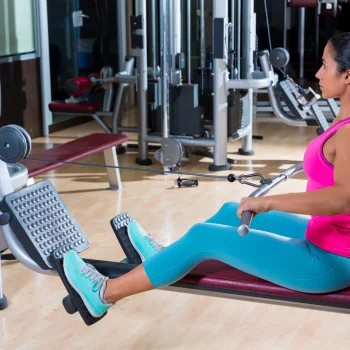
After putting it to the test, I can affirm that seated neutral-grip rows primarily target your lats, rhomboids, and lower traps.
It's an excellent way to build these muscles and improve overall back definition without heavy weights.
How to perform it:
- Take a seated position and place the band around your feet.
- Grasp the bands’ ends, keeping your back straight and your core engaged.
- Pull the band toward your waist, squeezing your shoulder blades together.
- Release the tension and return to the start position.
Related: Best Seated Cable Row Alternatives
Seated Lat Pulldown
The seated lat pulldown targets the lats near your shoulder blades while also working the traps, rhomboids, and biceps.
It's a fantastic exercise for enhancing your upper body strength and improving posture.
How to perform it:
- Sit on the floor and anchor the band above you.
- Hold the band’s ends, arms straight.
- Pull the band down towards your chest, keeping your back and head straight.
- Slowly let your arms extend back up, resisting the band's pull.
Also Read: Lat Pulldown Variations
Seated Close-Grip Pulldown
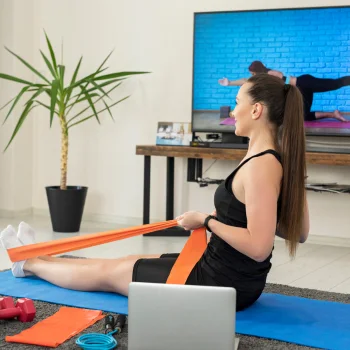
The seated close-grip pulldown is a great exercise for developing strength and definition in the lats and biceps.
Based on insights from ResearchGate, this exercise also stimulates the middle traps and rhomboids, helping to improve posture and reduce the risk of back injuries [1].
How to perform it:
- Anchor the band above you and sit on the floor.
- Grasp the band's ends with your hands close together.
- Pull the band to your chest and squeeze your shoulder blades together.
- Slowly return your hands upward, resisting the band's tension.
Bent Over Lat Pushdown
The bent over lat pushdown is an excellent band exercise that targets the teres major and lats.
This movement also activates the posterior chain muscles, including the glutes and hamstrings, improving overall body stability.
How to perform it:
- Anchor the resistance band above you.
- Stand away from the anchor, bend at the waist, and grab the band's ends.
- Push down and slightly forward, extending your arms and engaging your lats.
- Slowly return to the starting position, controlling the resistance of the band.
Resistance Band Rows Workout Routine

Here’s a balanced workout routine that targets multiple upper body areas.
Warm-up
- Jog in Place: 2 minutes
- Arm Circles: 30 seconds each, forward and backward
- Side Steps with Band: 1 minute
- Band Pull-Aparts: 1 minute
- Light Squats with Band: 1 minute
Workout
- Bent Over Rows: 3 sets of 12 reps
- Seated Neutral-Grip Row: 3 sets of 12-15 reps
- Seated Lat Pulldown: 3 sets of 12-15 reps
- Seated Close-Grip Pulldown: 3 sets of 12-15 reps
- Bent Over Lat Pushdown: 3 sets of 12-15 reps
Cooldown
- Walking: 3 minutes
- Chest Stretch: 30 seconds
- Lat Stretch with Band: 30 seconds on each side
What Is a Traditional Row Exercise?
Traditional back row exercises are strength training routines that target the back muscles, mimicking the motion of rowing a boat.
They primarily work the latissimus dorsi, rhomboids, biceps, and deltoids.
You can use multiple pieces of equipment like barbells or resistance bands to complement them.
Types of Resistance Bands

There are five resistance band types: tube, loop, therapy, figure 8, and power resistance. Here’s the difference:
- Tube Bands: These are long, thin bands with handles on each end. Tube bands are excellent for replicating gym exercises and providing different degrees of resistance.
- Loop Bands: Also known as mini bands, these are small, flat, and looped bands commonly used for lower body exercises, especially glute activation.
- Therapy Bands: They're often used in physiotherapy or light workout routines.
- Figure-8 Bands: Shaped like an 8, these bands have handles on both ends and are used for specific upper and lower body exercises.
- Power Resistance Bands: These thick-looped bands provide heavy resistance, commonly used for strength training and powerlifting exercises.
“Power-band resistance training produced greater results compared to conventional training in 1RM squat mass.”
- Edgar Katushabe, Department of Human Movement Sciences
Benefits of Training Using Resistance Bands

Training with resistance bands offers the following benefits:
- Increases strength and endurance - Per a study published by the National Institutes of Health (NIH), resistance bands can lead to gains in strength and power when compared to typical resistance training and conventional resistance training [2].
- Improves body composition - This includes increases in lean body mass and overall electromyography (EMG) activity.
- Improves functional capacity - Resistance band training can help improve daily function and prevent mobility restrictions.
- Reduces risk of metabolic syndrome - Based on a study from the National Institutes of Health (NIH), this condition can increase the likelihood of adverse health conditions such as type 2 diabetes and cardiovascular disease [3].
- Low cost and easy accessibility - Unlike certain gym equipment, resistance bands are a cost-effective way to work out and can be used in a variety of settings.
“Resistance training shows potential as an effective training methodology compared to conventional resistance training to improve performance variables.”
- Edgar Katushabe, Department of Human Movement Sciences
Which Muscles Does Resistance Band Rows Work?
Based on a study published by the National Institutes of Health (NIH), resistance band rows use several muscles in the lower body and core, including the inverters and evertors for ankle rotation, plantar flexors and dorsiflexors for ankle flexion, quadriceps for knee movement, and gluteals for hip actions [4].
Resistance band rows target muscles in your ankles, thighs, and buttocks, helping with movements such as rotation, flexion, and extension.
These exercises are great for training the trapezius, latissimus dorsi, and rhomboids.
FAQs
Can I Grow Muscle with a Resistance Band Exercise?
Yes, you can grow muscle with a resistance band exercise. They provide constant tension throughout the movement, stimulating muscle growth and improving muscle endurance.
How Many Calories Does a Resistance Band Row Burn?
A resistance band row workout burns between 200 and 300 calories per hour.
Can I Alter Between Light and Heavy Weights Exercises?
Yes, you can alternate between light and heavy weights exercises. This practice, known as “undulating periodization”, can help prevent plateaus and keep your muscles guessing, leading to better overall strength and muscle gains.
References:
- https://www.researchgate.net/publication/324133370
- https://www.ncbi.nlm.nih.gov/pmc/articles/PMC4060320/
- www.ncbi.nlm.nih.gov/pmc/articles/PMC8219266/
- www.ncbi.nlm.nih.gov/pmc/articles/PMC2953284/
About The Author
You May Also Like
